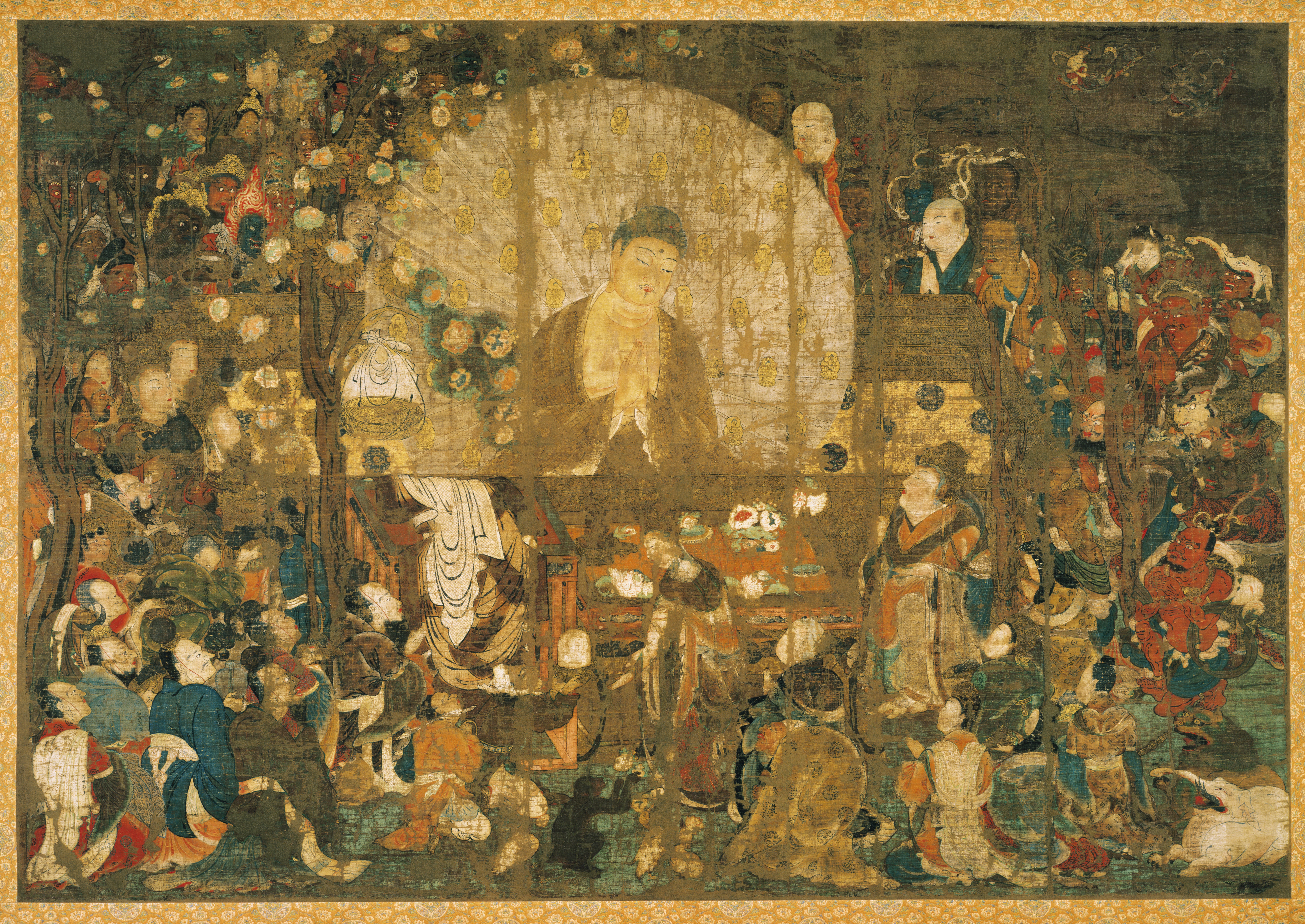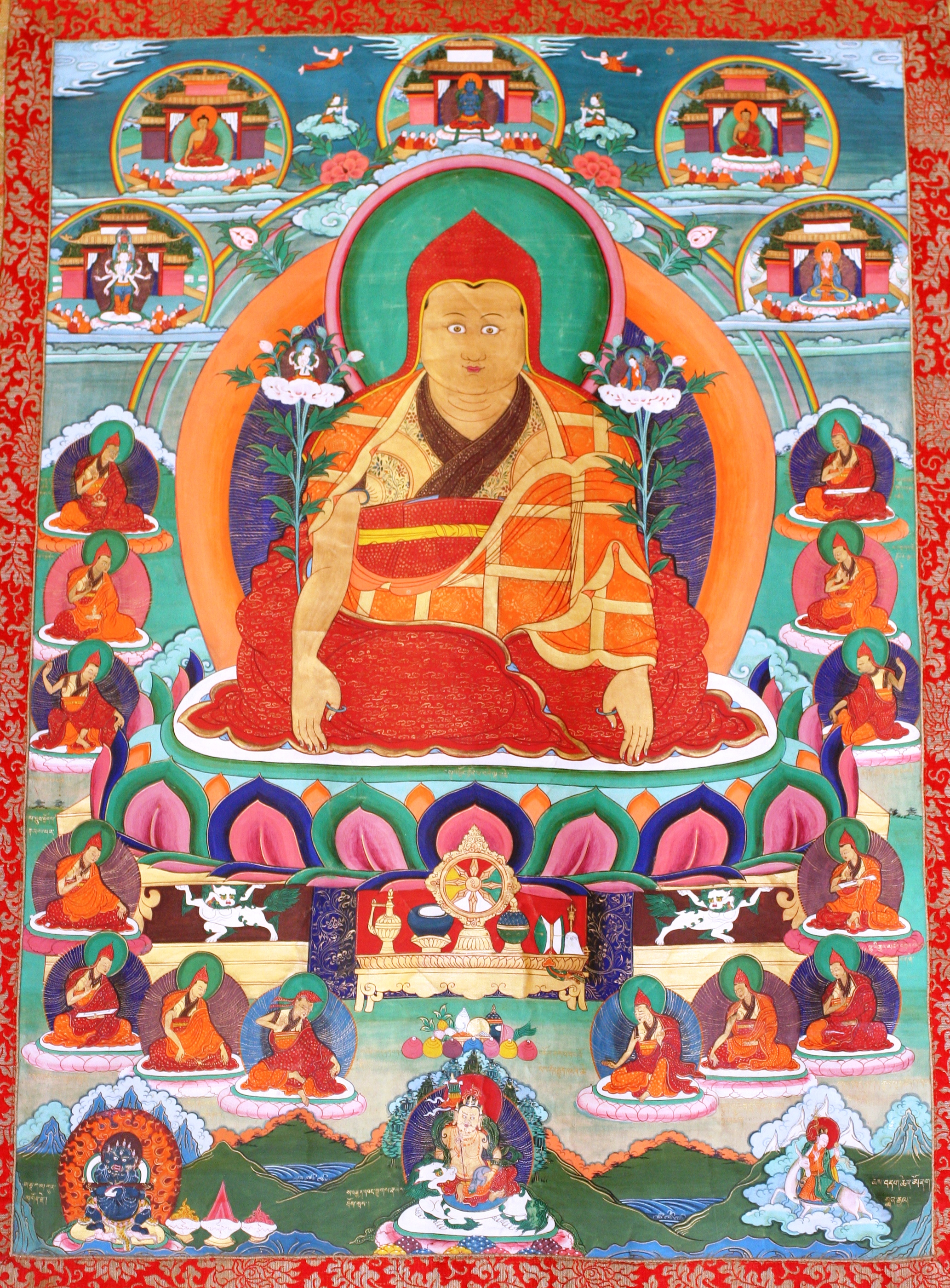|
Mahābheri Sūtra
The ''Great Drum Sūtra'' (MBhS, Sanskrit: *''Mahābherisūtra''; Chinese: 大法鼓經, ''Dà fǎ gǔ jīng,'' or ''*Mahābherīhārakaparivartasūtra, Sutra Chapter on the Beater of the Great Drum,'' Tibetan: '''phags pa rnga bo che chen po'i le'u zhes bya ba theg pa chen po'i mdo'') is a Mahayana Buddhist sutra of the tathāgatagarbha type.Radich, Michael (2015). "Tathāgatagarbha Scriptures." In Jonathan Silk, Oskar von Hinüber, Vincent Eltschinger (eds.): Brill's Encyclopedia of Buddhism, Volume 1: Literature and Languages. Leiden: Brill, pp. 267-268Jones, C.V.Beings, Non-Beings, and Buddhas: Contrasting Notions of tathāgatagarbha in the Anūnatvāpūrṇatvanirdeśaparivarta and *Mahābherī Sūtra. JOCBS. 2016(5): 53-84 The ''Mahābherisūtra'' focuses on buddha-nature (tathāgatagarbha), describing it as luminous, pure, permanent, eternal, everlasting, peaceful, and as a self ( ātman). According to C.V. Jones "the MBhS is committed to the idea that the liberation of Bu ... [...More Info...] [...Related Items...] OR: [Wikipedia] [Google] [Baidu] |
Mahayana Sutras
The Mahayana sutras are Buddhist texts that are accepted as wikt:canon, canonical and authentic Buddhist texts, ''buddhavacana'' in Mahayana, Mahayana Buddhist sanghas. These include three types of sutras: Those spoken by the Buddha; those spoken through the Buddha's blessings; and those spoken through mandate. They are largely preserved in Sanskrit manuscripts, and in translations such as the Tibetan Buddhist canon, and Chinese Buddhist canon. Several hundred Mahāyāna sutras survive in Sanskrit, Tibetan and Chinese translations. The Buddhist scholar Asanga classified the Mahāyāna sūtras as part of the ''Bodhisattva Tripiṭaka'', a collection of texts meant for bodhisattvas.Boin-Webb, Sara (tr). Rahula, Walpola (tr). Asanga. ''Abhidharma Samuccaya: The Compendium of Higher Teaching.'' 2001. pp. 199–200 Buddhists consider the most important Mahayana sutras to be the spoken teachings of Gautama Buddha, Shakyamuni Buddha. These were quickly recorded one year following his Ma ... [...More Info...] [...Related Items...] OR: [Wikipedia] [Google] [Baidu] |
Mara (demon)
Mara,, '; ; or ; ; also マーラ, ''Māra'' or 天魔, ''Tenma''; ; ; Tibetan Wylie: ''bdud''; ; ; ; in Buddhism, is a malignant celestial Asura king who tried to stop The Buddha, Prince Siddhartha from Awakening by trying to seduce him with his celestial Army and a vision of beautiful women who, in various legends, are often said to be Mara's daughters. In Buddhist cosmology, Mara is associated with death, rebirth and desire. Nyanaponika Thera has described Mara as "the personification of the forces antagonistic to enlightenment." He is Yama's fearsome persona and all beings associated with him, darkness and death, become forces of Mara. These forces consist of Asuras, Rakshasa, Pishacha, Pisacas, Aratis and animals. Origin His name is first mentioned in the ''Atharvaveda, Atharva Veda'' (1200 BCE–1000 BCE) as Mrtyu and Agha Mara, the evil slayer. He is called the "evil one who kills" and "Papiyan", denoting a being which is not only morally bad but intertwined wit ... [...More Info...] [...Related Items...] OR: [Wikipedia] [Google] [Baidu] |
Shentong
''Rangtong'' and ''shentong'' are two distinctive views on emptiness ( sunyata) and the two truths doctrine within Tibetan Buddhism. Rangtong (; "empty of self-nature") is a philosophical term in Tibetan Buddhism which is used by Tibetan defenders of shentong, like Dölpopa, to distinguish the majority Madhyamaka teaching on the nature of śūnyatā or "emptiness", namely that all phenomenon are empty of an enduring and/or unchanging essence or "self," and that this emptiness is not an absolute reality, but a mere nominal characterisation of phenomena. It is related to the '' prasangika'' approach, which argues that no positive statements should be made to deconstruct the notion of inherent existence, but only arguments which show the logical implications and absurdity of statements. This position is the mainstream Gelugpa interpretation of Madhyamaka, one of the main Mahayana schools, which dominates Vajrayana Buddhism. ''Shentong'' ( Wylie: ''gzhan stong'', "emptiness of othe ... [...More Info...] [...Related Items...] OR: [Wikipedia] [Google] [Baidu] |
Purity In Buddhism
Purity (Pali: ''Vissudhi'') is an important concept within much of Theravada and Mahayana Buddhism, although the implications of the resultant moral purification may be viewed differently in the varying traditions. The aim is to purify the personality of the Buddhist practitioner so that all moral and character defilements and defects ('' kleśas'' such as anger, ignorance and lust) are wiped away and nirvana can be obtained. Theravada Theravada Buddhism regards the path of self-purification as absolutely vital for reaching Nibbana. The main task of the Theravada Buddhist monk is to eradicate flaws in morality and character through meditation and moral cultivation, in alliance with the cultivation of insight or wisdom ( Paññā), so that the purity of Nibbana can be achieved. So important is this notion of purity in Theravada Buddhism that the famed Buddhist monk and commentator Buddhaghosa composed a central thesis on ''dhamma'' called ''The Path of Purification'' (''Visu ... [...More Info...] [...Related Items...] OR: [Wikipedia] [Google] [Baidu] |
Buddha-Nature
In Buddhist philosophy and soteriology, Buddha-nature ( Chinese: , Japanese: , , Sanskrit: ) is the innate potential for all sentient beings to become a Buddha or the fact that all sentient beings already have a pure Buddha-essence within themselves.Heng-Ching ShihThe Significance Of 'Tathagatagarbha' – A Positive Expression Of 'Sunyata'/ref> "Buddha-nature" is the common English translation for several related Mahāyāna Buddhism, Buddhist terms, most notably ''tathāgatagarbha'' and ''buddhadhātu'', but also ''sugatagarbha,'' and ''buddhagarbha''. ''Tathāgatagarbha'' can mean "the womb" or "embryo" (''garbha'') of the "thus-gone one" (''Tathagata, tathāgata''), and can also mean "containing a ''tathāgata''"''. Buddhadhātu'' can mean "buddha-element", "buddha-realm", or "buddha-substrate". Buddha-nature has a wide range of (sometimes conflicting) meanings in Indian Buddhism and later in East Asian Buddhism, East Asian and Tibetan Buddhism, Tibetan Buddhist literatur ... [...More Info...] [...Related Items...] OR: [Wikipedia] [Google] [Baidu] |
Emptiness
Emptiness as a human condition is a sense of generalized boredom, social alienation, nihilism, and apathy. Feelings of emptiness often accompany dysthymia, depression (mood), depression, loneliness, anhedonia, wiktionary:despair, despair, or other mental/emotional disorders, including schizoid personality disorder, post-traumatic stress disorder, attention deficit hyperactivity disorder, schizotypal personality disorder and borderline personality disorder. A sense of emptiness is also part of a natural process of grief, as resulting death of a loved one, or other significant changes. The particular meanings of "emptiness" vary with the particular context and the religious or cultural tradition in which it is used. While Christianity and Western sociologists and psychologists view a state of emptiness as a negative, unwanted condition, in some Eastern philosophies such as Buddhist philosophy and Taoism, emptiness (Śūnyatā) represents seeing through the Pratītyasamutpāda, il ... [...More Info...] [...Related Items...] OR: [Wikipedia] [Google] [Baidu] |
Nirvana (Buddhism)
Nirvana or nibbana (Sanskrit: निर्वाण; International Alphabet of Sanskrit Transliteration, IAST: '; Pali: ') is the extinguishing of the passions, the "blowing out" or "quenching" of the activity of the grasping mind and its related unease. Nirvana is the goal of many Buddhism, Buddhist paths, and leads to the soteriological release from dukkha ('suffering') and rebirths in ''Saṃsāra (Buddhism), saṃsāra''. Nirvana is part of the Third Truth on "cessation of ''dukkha''" in the Four Noble Truths, and the "''summum bonum'' of Buddhism and goal of the Noble Eightfold Path, Eightfold Path." In all forms of Buddhism, Nirvana is regarded as the highest or supreme religious goal. It is often described as the unconditioned or uncompounded (Skt.: asaṃskṛta, Pali: asankhata), meaning it is beyond all forms of conditionality — not subject to change, decay, or the limitations of time and space. Nirvana is typically seen as being outside the realm of dependent ari ... [...More Info...] [...Related Items...] OR: [Wikipedia] [Google] [Baidu] |
Skillful Means
In Buddhism, upaya (Sanskrit: उपाय, , ''expedient means'', ''pedagogy'') is an aspect of guidance along the Buddhist paths to liberation where a conscious, voluntary action "is driven by an incomplete reasoning" about its direction. Upaya is often used with ''kaushalya'' (कौशल्य, "cleverness"), ''upaya-kaushalya'' meaning "skill in means". Upaya-kaushalya is a concept emphasizing that practitioners may use their own specific methods or techniques that fit the situation in order to gain enlightenment. The implication is that even if a technique, view, etc., is not ultimately "true" in the highest sense, it may still be an ''expedient'' practice to perform or view to hold; i.e., it may bring the practitioner closer to the true realization in a similar way. The exercise of skill to which it refers, the ability to adapt one's message to the audience, is of enormous importance in the Pali Canon. The Digital Dictionary of Buddhism notes that rendering the Chinese ... [...More Info...] [...Related Items...] OR: [Wikipedia] [Google] [Baidu] |
Anattā
In Buddhism, the term ''anattā'' () or ''anātman'' () is the doctrine of "no-self" – that no unchanging, permanent self or essence can be found in any phenomenon. While often interpreted as a doctrine denying the existence of a self, ''anatman'' is more accurately described as a strategy to attain non-attachment by recognizing everything as impermanent, while staying silent on the ultimate existence of an unchanging essence. In contrast, dominant schools of Hinduism assert the existence of Ātman as pure awareness or witness-consciousness, "reify ngconsciousness as an eternal self". Etymology and nomenclature ''Anattā'' is a composite Pali word consisting of ''an'' (not) and ''attā'' (self-existent essence). The term refers to the central Buddhist concept that there is no phenomenon that has a permanent, unchanging "self" or essence. It is one of the three characteristics of all existence, together with '' dukkha'' (suffering, dissatisfaction) and '' anicca'' (imperm ... [...More Info...] [...Related Items...] OR: [Wikipedia] [Google] [Baidu] |
Sassatavada
Sassatavada (Pali), also śāśvata-dṛṣṭi (Sanskrit), usually translated "eternalism", is a kind of thinking rejected by the Buddha in the nikayas (and agamas). One example of it is the belief that the individual has an unchanging self. Views of this kind were held at the Buddha's time by a variety of groups. The Buddha rejected this and the opposite concept of ''ucchedavada'' ( annihilationism) on both logical and epistemic grounds. He proposed a Middle Way between these extremes, relying not on ontology Ontology is the philosophical study of existence, being. It is traditionally understood as the subdiscipline of metaphysics focused on the most general features of reality. As one of the most fundamental concepts, being encompasses all of realit ... but on causality. Eternalism included the belief that the extinction of things means their latency and the production of things means their manifestation — this violates the Buddha's principle of the middle way.K. Venkat ... [...More Info...] [...Related Items...] OR: [Wikipedia] [Google] [Baidu] |
Annihilationism
In Christianity, annihilationism (also known as extinctionism or destructionism) is the belief that after the Last Judgment, all damned humans and fallen angels including Satan will be totally destroyed and their consciousness extinguished. Annihilationism stands in contrast to both the belief in eternal torment and to the universalist belief that everyone will be saved. Partial annihilationism holds that unsaved humans are obliterated but demonic beings suffer forever. Annihilationism is directly related to Christian conditionalism, the idea that a human soul is not immortal unless given eternal life. Annihilationism asserts that God will destroy and cremate the wicked, leaving only the righteous to live on in immortality. Thus those who do not repent of their sins are eventually destroyed because of the incompatibility of sin with God's holy character. Seventh-day Adventists posit that living in eternal hell is a false doctrine of pagan origin, as the wicked will perish in ... [...More Info...] [...Related Items...] OR: [Wikipedia] [Google] [Baidu] |






